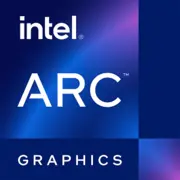Intel Arc A350M

Intel Arc A350M: A Graphics Accelerator for Balancing Work and Play
April 2025
Introduction
Since the release of the first Intel Arc graphics cards in 2022, the company has significantly strengthened its position in the discrete graphics market. The Arc A350M model, aimed at mobile devices and compact PCs, remains relevant in 2025 due to driver updates and optimizations. Let's explore what makes this card noteworthy and who it is suitable for.
Architecture and Key Features
Xe-HPG Architecture: The A350M is built on a hybrid Xe-HPG architecture that combines elements for gaming and professional tasks. The manufacturing process is 6 nm from TSMC, providing a balance between energy efficiency and performance.
Unique Features:
- Ray Tracing: Hardware ray tracing using Xe-core blocks. Despite modest performance (up to 2x speed increase compared to software rendering), driver improvements in 2025 have enhanced stability.
- XeSS (Xe Super Sampling): AI upscaling with support for resolutions up to 4K. In optimized games (such as Cyberpunk 2077: Phantom Liberty), the FPS boost reaches 30-40%.
- FidelityFX Compatibility: Support for AMD technologies, including FSR 3.0, broadening the list of optimized projects.
Memory: Fast but Compact
- Type and Size: GDDR6 4 GB with a 96-bit bus. For 2025, this size is modest, but sufficient for 1080p gaming.
- Bandwidth: 168 GB/s. Allows comfortable handling of textures in medium-weight games, but may experience stutters in 4K due to VRAM limitations.
- Impact on Performance: In Apex Legends (High settings, 1080p), when memory is insufficient, FPS drops by 15-20%, but XeSS compensates for this by reducing workload.
Gaming Performance: Modest but Stable
The card is aimed at 1080p gaming but can also handle 1440p in less demanding projects:
- Cyberpunk 2077 (2025): 45-50 FPS (Medium, XeSS Balanced, ray tracing off). With RT enabled, it drops to 25-30 FPS.
- Fortnite (Chapter 6): 75-80 FPS (Epic, DLSS Performance).
- Hogwarts Legacy 2: 60 FPS (High, 1080p, no RT).
Ray Tracing: Activating RT decreases FPS by 35-50%, but with XeSS/FSR 3.0, gameplay is still reasonable (for example, Control: Ultimate Edition — 40 FPS on Medium RT).
Professional Tasks: More Than Just Gaming
- Video Editing: Rendering acceleration in DaVinci Resolve and Premiere Pro thanks to AV1 and HEVC support. Exporting a 10-minute 4K video takes about 8 minutes.
- 3D Modeling: In Blender (using the Intel oneAPI plugin), rendering a medium complexity scene takes around 12 minutes. For complex tasks, it’s better to choose cards with larger memory.
- Scientific Computing: Support for OpenCL and SYCL, but CUDA is not available. Suitable for training simple neural networks (like TensorFlow with optimizations for Xe-cores).
Power Consumption and Heat Dissipation
- TDP: 35-40 W. Ideal for thin laptops and compact PCs.
- Cooling: Passive and hybrid systems manage without throttling. In gaming laptops (like the ASUS ZenBook Pro 14), temperatures do not exceed 75°C.
- Recommendations: For desktop builds with an external GPU — a case with 2-3 fans and ventilation openings.
Competitor Comparison
- NVIDIA GeForce RTX 3050 Mobile (6 GB): About 15-20% faster in games with DLSS 3.5, but more expensive ($550 compared to $400 for A350M).
- AMD Radeon RX 6500M (4 GB): Comparable in FPS but less effective with ray tracing. Price — $380.
- Intel Arc A370M: The higher-end model with 6 GB GDDR6. Performance gap — 10-15%, price — $450.
Conclusion: The A350M stands out due to its price and support for AV1 but lags in RT scenes.
Practical Tips
- Power Supply: For PCs with an external GPU — at least 400 W (using MSI MAG A400DN as an example).
- Compatibility: Requires PCIe 4.0 x8. Motherboards with Intel 600+ and AMD B550+ chipsets support it without issues.
- Drivers: As of 2025, stability is on par with NVIDIA. It's recommended to update via Intel Driver & Support Assistant.
Pros and Cons
✔️ Pros:
- Price of $400 for new devices.
- Support for AV1 and XeSS.
- Low power consumption.
❌ Cons:
- Only 4 GB of memory.
- Limited performance in 4K.
- RT requires compromises.
Final Conclusion: Who is the Arc A350M Suitable For?
This graphics card is an ideal choice for:
1. Budget Gamers looking to play at 1080p with moderate settings.
2. Content Creators who value AV1 encoding acceleration.
3. Owners of Thin Laptops where silence and longevity are important.
The Intel Arc A350M proves that even three years after its release, effective optimization and a reasonable price can keep a device relevant. If you don't need ultimate 4K gaming but want stability and modern technology — this is a solid option.
Basic
Memory Specifications
Theoretical Performance
Miscellaneous
Benchmarks
Compared to Other GPU
Related GPU Comparisons
Share in social media
Or Link To Us
<a href="https://cputronic.com/en/gpu/intel-arc-a350m" target="_blank">Intel Arc A350M</a>
